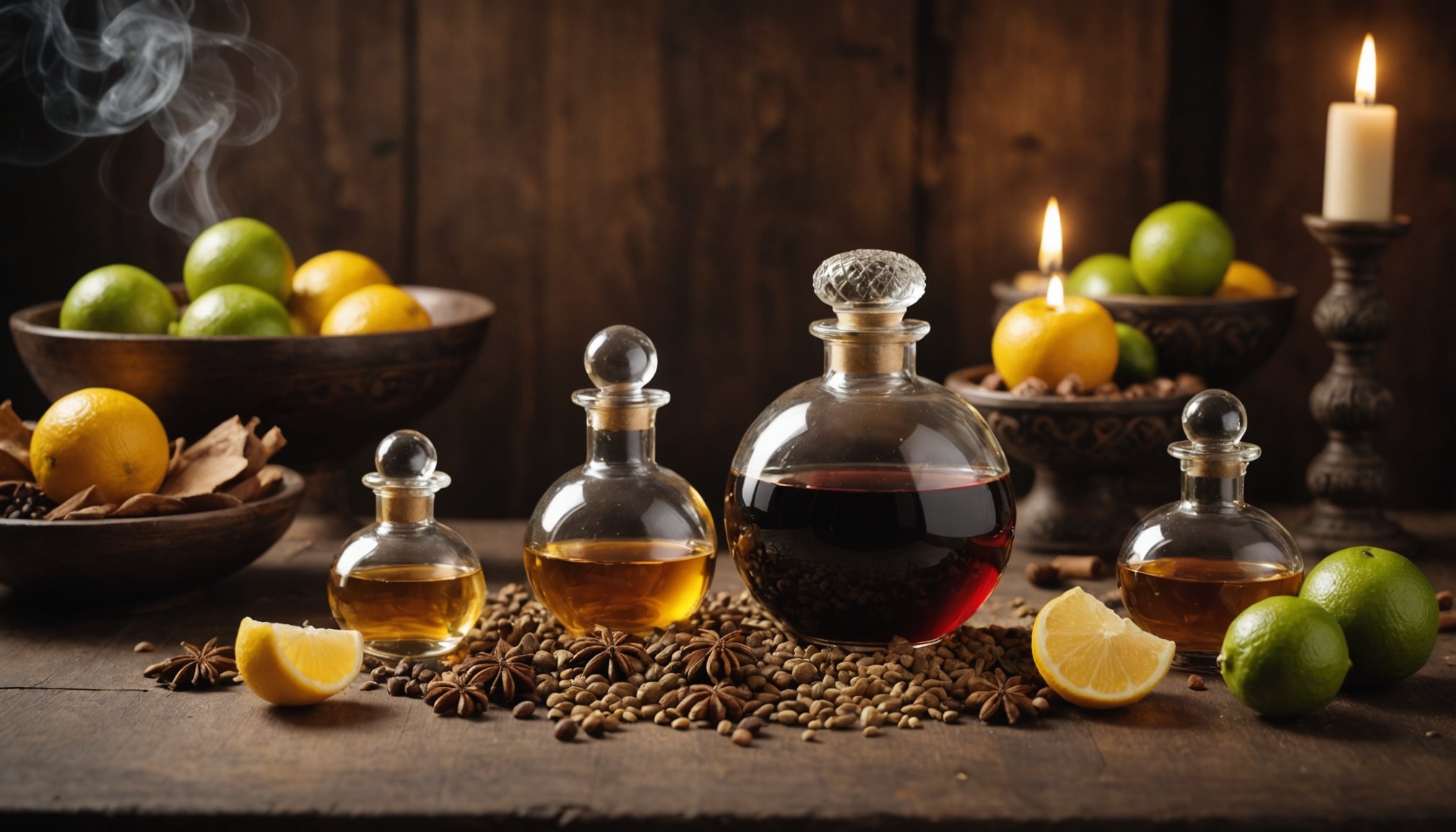Global Fragrance Traditions: A Sensory Adventure
In the vast and intricate world of fragrances, each scent tells a story that can transport us to different times and places. If you’re curious about the diverse and rich history of fragrances around the globe, you might want to embark on a sensory journey to explore these traditions.
The Evolution of Fragrance Trends
The global fragrance market is undergoing a significant transformation, driven by evolving consumer values and technological advancements. By 2025, the market is expected to reach $52.4 billion, with a strong focus on hyper-personalization, sustainability, and wellness-infused scents1.
In the same genre : Essential Tips for Caring for Delicate Lace Fabrics: How to Wash and Preserve Your Garments
Hyper-Personalization in Fragrances
Hyper-personalization is revolutionizing the way consumers interact with fragrances. Companies like iRomaScents are using AI to provide personalized scent recommendations based on individual preferences and mood patterns. “Imagine a world where fragrance isn’t just a passive experience but an interactive and adaptive one,” says Avner Gal, co-founder of iRomaScents. This technology simplifies the fragrance selection process, increases customer engagement, and offers data-driven insights to brands1.
Sustainability and Luxury in the Fragrance Industry
The demand for sustainable fragrances is reshaping the industry’s definition of luxury. Eco-conscious consumers are driving this change, and brands that align with these values are gaining a competitive edge. Erin Berry, co-founder of iRomaScents, highlights the challenges and opportunities: “Challenges include sourcing biodegradable materials, developing refillable packaging, and ensuring ethically sourced ingredients without compromising on quality or luxury appeal”1.
Additional reading : Fragrance rituals around the world: a sensory journey
Key Challenges and Opportunities in Sustainable Fragrances
- Sourcing Biodegradable Materials: Ensuring that packaging and ingredients are environmentally friendly.
- Refillable Packaging: Developing innovative packaging solutions that reduce waste.
- Ethically Sourced Ingredients: Maintaining high-quality ingredients while adhering to ethical sourcing practices.
- Luxury Appeal: Balancing sustainability with the luxury appeal that consumers expect.
The Wellness Wave in Fragrances
Wellness-infused scents are gaining traction as consumers increasingly seek fragrances that offer more than just olfactory pleasure. Functional fragrances that blend aromatherapy with luxury are becoming popular. These scents are designed to reduce stress, improve focus, or energize users. For example, ingredients like lavender for relaxation or citrus for energy are being incorporated into fragrances to deliver therapeutic benefits while maintaining luxury appeal1.
Examples of Wellness-Infused Fragrances
- Lavender and Chamomile: Known for their calming effects, these ingredients are often used in relaxation-focused fragrances.
- Citrus and Mint: Energizing scents that can improve focus and boost mood.
- Vanilla and Bergamot: Soothing and uplifting ingredients that combine relaxation with a sense of freshness.
Olfactory Trends and Consumer Preferences
The fragrance industry is witnessing a resurgence of nostalgic fragrances with a contemporary edge. Gen Z consumers are particularly drawn to vintage colognes from brands like Dior and Armani, seeking fragrances that embody stories and traditions. “Wearing a vintage fragrance is not just about the aroma; it’s about embodying a narrative that resonates with their values and aspirations,” says Avner Gal1.
Key Olfactory Trends for 2025
- Gourmand Fragrances: Strong momentum in gourmand fragrances, particularly with notes of pistachio and vanilla.
- Iconic Florals: A renaissance of iconic florals like rose, peony, violet, and orange flower.
- Fougère Category: Dominating the men’s market and making inroads into women’s and genderful segments2.
The Role of Technology in Fragrance Discovery
AI technology is transforming how consumers discover and experience fragrances. Tools like iRomaScents’ AI Wizard provide personalized scent recommendations and virtual scent simulations, enhancing consumer interactions and simplifying the fragrance selection process. “Our AI Wizard provides customers with credible recommendations to find the perfect, personalized option with sample spritzes along the way,” explains Gal1.
How AI is Changing Fragrance Selection
- Virtual Scent Simulations: Allowing consumers to experience fragrances virtually before making a purchase.
- Interactive Design Workshops: Enabling consumers to engage in interactive design processes to create their own fragrances.
- Data-Driven Insights: Providing brands with valuable data on consumer preferences and trends.
Experiential Retail and Sensory Experiences
The way consumers purchase fragrances is also evolving, with a strong emphasis on experiential retail. Physical stores remain dominant, especially for Gen Z consumers who often transition from online discovery on platforms like TikTok to in-store purchases. “Experiential spaces will dominate luxury engagement,” notes The Fragrance Shop, highlighting the importance of engaging décor, personalized services, and augmented reality (AR) in enhancing the shopping experience2.
Key Features of Experiential Retail
- Engaging Décor: Creating immersive and visually appealing store environments.
- Personalized Services: Offering tailored recommendations and personalized fragrance consultations.
- Augmented Reality (AR): Enhancing virtual sampling experiences and simulating scents through descriptive multimedia storytelling.
- Multi-Sensory Experiences: Engaging multiple senses through pop-up scent bars and sensory booths with visual, audio, and tactile elements.
Global Fragrance Traditions: A Rich History
Fragrance traditions vary widely around the world, each with its own rich history and cultural significance.
Fragrance Traditions in Different Regions
- Grasse, France: Known as the perfume capital of the world, Grasse has a long history of perfumery dating back to the 16th century.
- Key Ingredients: Rose, jasmine, and orange blossom.
- Notable Houses: Chanel, Dior, and Guerlain.
- India: Ayurvedic fragrances are deeply rooted in Indian culture, often featuring ingredients like turmeric and sandalwood.
- Key Ingredients: Turmeric, sandalwood, and bergamot.
- Notable Practices: The use of fragrances in traditional Ayurvedic rituals and ceremonies.
- Middle East: Oud and amber are staples in Middle Eastern perfumery, known for their rich, intense scents.
- Key Ingredients: Oud, amber, and rose.
- Notable Houses: Amouage and By Kilian.
A Guided Tour of the Perfume World
Embarking on a guided tour of the perfume world can be a fascinating journey. Here’s a glimpse into what such a tour might look like:
London: The Heart of British Perfumery
- Somerset House: A historic venue that hosts various perfume exhibitions and events.
- Malone London: A boutique perfume house known for its unique and bespoke fragrances.
- Perfume Studios: Many perfume studios in London offer workshops and classes where you can learn about the art of perfumery.
Grasse: The Perfume Capital
- House Studios: Visiting the studios of renowned perfume houses like Chanel and Dior.
- Fragrance Museums: Exploring museums dedicated to the history and art of perfumery.
- Fields and Laboratories: Seeing the fields where ingredients are grown and the laboratories where fragrances are crafted.
Practical Insights and Actionable Advice
For those looking to deepen their understanding and appreciation of fragrances, here are some practical insights and actionable advice:
Building a Fragrance Wardrobe
- Identify Your Preferences: Start by understanding what scents you like and why.
- Explore Different Categories: Try out various fragrance categories, such as florals, orientals, and gourmands.
- Seasonal Selections: Choose fragrances that suit different seasons and occasions.
Using Technology to Your Advantage
- AI-Driven Platforms: Use platforms like iRomaScents to get personalized fragrance recommendations.
- Virtual Try-Ons: Utilize AR and virtual try-on features to experience fragrances before purchasing.
- Data Analytics: Follow trends and insights provided by data analytics to stay updated on consumer preferences.
The world of fragrances is a sensory adventure that spans cultures, traditions, and technological innovations. As the industry continues to evolve, it’s clear that hyper-personalization, sustainability, and wellness-infused scents will remain at the forefront. Whether you’re exploring nostalgic fragrances, leveraging AI for personalized recommendations, or engaging in experiential retail, the journey through the perfume world is one that promises to be more personal, adaptive, and engaging than ever.
Fragrance Trend
Description
Key Ingredients
Hyper-Personalization
Using AI to provide personalized scent recommendations
Varies based on individual preferences
Sustainability
Focusing on biodegradable materials, refillable packaging, and ethically sourced ingredients
Eco-friendly materials, natural ingredients
Wellness-Infused Scents
Creating fragrances with therapeutic benefits like relaxation and energy
Lavender, citrus, vanilla, bergamot
Nostalgic Fragrances
Reimagining timeless notes with contemporary twists
Rose, jasmine, smoky, spicy, herbal undertones
Gourmand Fragrances
Fragrances with strong food notes like pistachio and vanilla
Pistachio, vanilla, gourmand notes
Iconic Florals
A renaissance of classic floral scents like rose and peony
Rose, peony, violet, orange flower
- Hyper-Personalization: Using AI to provide personalized scent recommendations.
- Sustainability: Focusing on biodegradable materials, refillable packaging, and ethically sourced ingredients.
- Wellness-Infused Scents: Creating fragrances with therapeutic benefits like relaxation and energy.
- Nostalgic Fragrances: Reimagining timeless notes with contemporary twists.
- Gourmand Fragrances: Fragrances with strong food notes like pistachio and vanilla.
- Iconic Florals: A renaissance of classic floral scents like rose and peony.
"Fragrance brands balance nostalgia with modernity by reimagining timeless notes like rose and jasmine with unexpected twists," said Avner Gal, co-founder of iRomaScents1.
"Today’s consumers, regardless of age, are building ‘fragrance wardrobes’ that cater to specific moods, whether it’s the desire for adventure, relaxation, or nostalgia," said Erin Berry, co-founder of iRomaScents1.
Key Takeaways:
- The global fragrance market is expected to reach $52.4 billion by 2025.
- Hyper-personalization, sustainability, and wellness-infused scents are dominant trends.
- AI technology is transforming fragrance discovery and selection.
- Experiential retail is becoming increasingly important.











